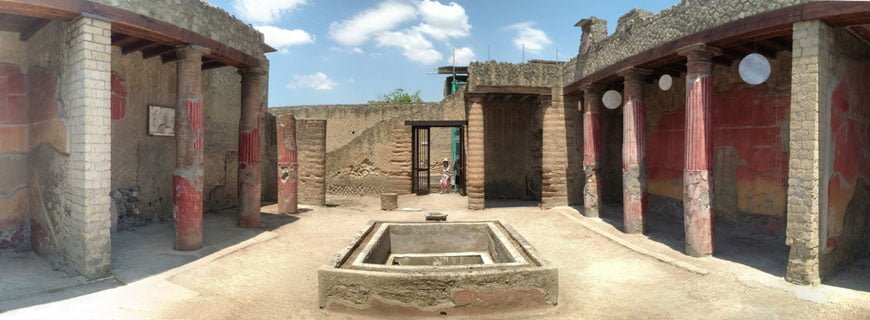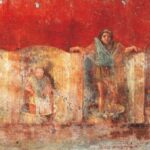Chapters
The year 79 CE turned out to be the last in the life of many ancient inhabitants living at the foot of Mount Vesuvius. Thanks to the well-preserved monuments and remains, we are able to get to know the life of the ancients better after thousands of years. Importantly, however, the fate of Pompeii and Herculaneum – the two most famous destroyed Roman cities – was not the same.
Course of eruption
Pompeii was the first victim of the volcanic eruption. The eruption took place in the afternoon of one day in late summer (as pointed out by Cassius Dio1) or in the autumn, as indicated by the archaeological discoveries and their conclusions (for more information, e.g. here). The wind then blew towards the southeast. The explosion threw up (estimated at 15-30 km) a huge amount of volcanic material (pumice, ashes), which after some time began to fall. Pompeii was covered with numerous pieces of stone, which wounded people in the head and most often killed them when they fell. Moreover, the enormous amount of volcanic material that fell on the Pompeian buildings meant that the ceilings could not bear the weight, and the inhabitants hidden inside were crushed. In addition, the fallen volcanic material heated the tiles to 140 degrees Celsius, weakening the structure and heating the interior.
Herculaneum suffered little during the first eruption, as it was west of the mountain. Most of the inhabitants of Herculaneum decided to flee, feeling the earthquake and seeing a powerful cloud over the Vesuvius crater.
At some point during the night or early morning of the following day, there was a second phase of the outbreak. A pyroclastic avalanche (a mixture of hot gases around 500 degrees Celsius, ashes and rock crumbs) ran down the slope of Vesuvius, which mainly hit Herculaneum. The pyroclastic flow sped at over 160 km/h, preventing any escape for those who chose to stay or could not escape. A cloud of gases burned people, animals and plants on its way. Many people flocking to the rooms have died from thermal shock.
Later, there were repeated “liquid” avalanches, which covered Herculaneum with a layer of volcanic mud, even 25 m thick. It was this large amount of material that allowed Herculaneum to partially keep in very good condition and hide the city, among others, against thieves.
Buildings
In Pompeii, very few buildings retained their upper storeys or roofs – the reason was the weight of falling debris and dust that collapsed the structures. Most of the lower layers of the walls have survived.
Due to the fact that Herculaneum was not “bombed” by numerous stones and was covered with more dust and volcanic material, the structures in Herculaneum are much better preserved; just like the frescoes, the colours of which are still mostly incredibly vivid. The vacuum in which the finds were found also played a large part here.
Human remains
There were certainly more casualties at Pompeii, for that is where the winds directed the ash and other volcanic materials; the inhabitants of Herculaneum had more time to escape. In Pompeii, most people died as a result of a strong impact or being crushed by collapsing structures. The dust that fell and covered the bodies gradually stiffened on the body. During this time, soft tissues were degraded and the space between the dust and the bones remained. The Italian researcher Giuseppe Fiorelli in the 19th century developed a method of making plaster casts of bodies. Through a small hole, he poured stucco plaster, which filled the entire empty space. After setting the plaster, he removed the ash layer, revealing the castings of bodies, objects, building elements, etc. Later, transparent material was used, which allowed seeing the small objects, and bones hidden inside the cast. Thanks to Fiorelli, to this day we can understand the terror of the inhabitants of the destroyed cities.
In Herculaneum for a long time, it was impossible to find any traces of the victims of the cataclysm – it was suspected that virtually all inhabitants survived. However, in 1981, scientists managed to come across an unusual find – 55 skeletons (30 adult men, 13 adult women, and 12 children) were found on the beach and in the shoreline boathouses. The inhabitants of Herculaneum, waiting on the shore to rescue from the sea, died suddenly as a result of a strong heat – about 500°C – in the second surge. The high temperature caused the limbs to contract and the bones and teeth to break. Some of the discovered skeletons can be admired at the Museum of Anthropology in Naples.
Importantly, Herculaneum also preserved wooden house pieces, clothes, and even food that have been charred and preserved to this day, giving amazing insight into everyday life in the ancient world.










